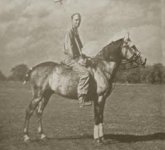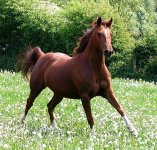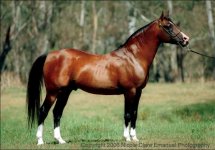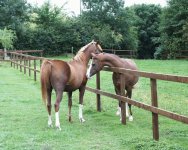DOMESTIC ARABIANS
One has to wonder why horses bred in the United States were never called "American Arabians," but they have always been referred to as "Domestic." Heavily based on Crabbet, the Domestic Arabian is not too different from that of most Americans -- lots of English, with strains from other nations thrown in. Even though the colonists brought "oriental" stallions from England to upgrade their Thoroughbred stock, these owners did not breed purebred Arabians.
The turning point for purebred Arabian breeding came with the 1893 Chicago World's Fair, which provided an opportunity for the first sizeable importation of Arabians to the United States. The Turkish government organized an exhibition of 45 horses, some of which were of high quality. When the exhibition fell upon financial straits the horses were auctioned in 1894 after whetting the American breeder's interest in breeding purebred Arabians in the United States. In the ensuing years, stud farms were founded which would write the early history of purebred Arabian horse breeding in this country. The first Arabian breeders were located principally in the East and Midwest, although as time passed, the center of action for the Arabian horse moved to California. Early breeders imported from Egypt, the desert and England, largely because other sources of bloodstock common today-notably Poland, Russia and Spain-were not especially open to foreign exportation (there were two importations from Poland and one from Spain in the 1930's; otherwise, the horses came from the traditional sources). The breeders showed a willingness to cross bloodlines with little of the adherence to maintaining nationalities of origin which became common and lucrative by the 1980's. They required their animals to also be useful, often training horses for endurance, polo and jumping. There was little, if any, importance placed on a horse that simply stood around and looked pretty.
Among the visitors to the 1893 World's Fair was young political cartoonist Homer Davenport, who was so intrigued by the horses he saw that he spent the next few years studying bloodlines and tracing the World's Fair Arabians after the bankruptcy sale. In 1906, with the blessings of President Theodore Roosevelt, the artist/horseman organized his first expedition to the Middle East, financed by Peter B. Bradley who had purchased many of the World's Fair horses
Even before his breeding program was organized, Homer Davenport made history in American Arabians. He and other early Arabian enthusiasts formed what would become the Arabian Horse Registry of America in 1908. For a long time, many owners double registered their horses with the Jockey Club, which accepted Arabian horses in the American Stud Book until 1943. By 1910, he had imported four more Arabians from England, mainly from Crabbet Park. As his breeding program developed, he became one of the best known of the early American breeders.
His most famous stallion was *Abu Zeyd, a Mesaoud son imported from Crabbet Park. His program is maintained today by breeders who use the descendants of his horses to perpetuate "Davenport Arabians." At the time that purebred Arabian breeding began to grow in the United States, there were few sources of horses. The Crabbet influence-either straight Crabbet breeding or Crabbet combined with outcrosses-dominated the American Arabian scene for the first six decades of the twentieth century; it was not until the influx of Polish and Egyptian horses in the sixties that the focus of American breeding began to shift and widen.
In 1912, William Robinson Brown established Maynesboro Stud in Berlin, New Hampshire with horses purchased from early breeders. Eventually he added farms in Iowa and Wyoming, and in a breeding career spanning more than 20 years, imported 33 horses, from Crabbet Park, France and Egypt. The Depression forced the stud's dispersal in 1933, and the Brown horses were sold to the Kellogg Ranch, Roger Selby, William Randolph Hearst, General Dickinson at Traveler's Rest and a few others.
Albert W. Harris was a Chicago banker with a farm in Lake Geneva, Wisconsin, when his interest in Indian ponies grew to encompass Arabians. He acquired his first Arabian from the Davenport importation of 1908, and won the first major endurance race in this country on a Brown horse. His breeding operation was known as Kemah Arabian Farm, but like the Davenport Arabians, his horses through the years commonly have been referred to with their breeder's name, as "Harris Arabians."
W.K. Kellogg, who achieved fame as the cereal king from Battle Creek, Michigan, founded his Arabian horse ranch in Pomona, California in 1925, the realization of a childhood dream. He imported horses from Crabbet Park during the 20's, the most notable of whom was the very successful stallion, *Raseyn. Probably more than any one person, Kellogg was responsible for the widespread popularity of the Arabian in Southern California. Every Sunday afternoon, the Kellogg Ranch staged an exhibition of Arabian horses, and these weekly shows were famous and very well attended. In the days before the Los Angeles area was known for its smog, spectators would travel the hour or two drive east of the city to see the horses. The air was crystal clear, the sunshine warm, and the Arabians well-schooled. The horses demonstrated high school steps, tricks, gaits, jumping-nearly everything a horse could be taught, the Kellogg horses could do. Many a love affair with the Arabian horse began on a Sunday afternoon at the Kellogg Ranch. Raseyn established a virtual dynasty during his years at stud. One of his most famous sons was Ferseyn, for many years a leading sire of champions, who in turn sired Ferneyn, who sired Ferzon, the most important stallion in the Gainey Arabians program. Ferseyn also sired Amerigo (x Szarza, a Polish import), sire of Khemosabi, and Kontiki, one of the best Arabian racehorses in the U.S. Another son of *Raseyn was Sureyn, again a leading sire of champions.
The Ranch was finally given to the California Polytechnic Institute, and is used today for Cal Poly's equine program. What W.K. Kellogg's ranch was to Southern California, the Roger Selby Stud of Portsmouth, Ohio, was to the East. Selby imported most of his stock from Crabbet Park between 1928 and 1933, although one of his most famous stallions, *Mirage, had come to Crabbet from the desert. In his 1932 importation from Crabbet was the grey stallion *Raffles, destined to become one of the best-known and most prolific sires in the development of the Arabian breed in this country. Raffles was pony-sized, standing under 14 hands, but there was nothing small about his contribution; he was one of the most preeminent stallions in the country throughout his career. Among his famous offspring were the stallions Indraff, later one of the most influential sires at Al Marah Arabians; Azraff (x Azja IV, imported from Poland by Henry Babson), who in turn sired Comar Bey Beau and Galizon, among many others; Handcyraff, Rapture, and the full brothers Aaraf and Aarief. *Raffles and his near-relation *Raseyn (both stallions were by the Crabbet super-sire, Skowronek) substantially outdistanced their rivals during their productive years in headcount of offspring and championship records.
One of the most eclectic of the early breeders was Brigadier General J.M. Dickinson, who founded his Arabian stud in 1930 at Travelers Rest Farm in Franklin, Tennessee, an old Southern estate which had been in his family since the time of Andrew Jackson. General Dickinson was a well-rounded horseman (Travelers Rest had previously been noted as a Saddlebred nursery) who acquired some of his first Arabians from the Kellogg Ranch and Maynesboro Stud-Egyptian and French stock, and homebreds. He later added Crabbet-bred horses from the Babson Stud, some of the Harris horses, and imported from Egypt and from Brazil.
Travelers Rest produced some of the best Arabians in the country, as General Dickinson experimented with the many crosses his varied bloodlines offered, successfully mixing Polish, Egyptian and domestic. He usually maintained between 30 and 40 broodmares on the farm; his most famous stallions were the Polish *Czubuthan, the Egyptian *Nasr, and the domestic Gulastra, although he used many others to a lesser extent. The black stallion Hallany Mistanny, who later in his life would enjoy success and popularity as a sire, was bred at Travelers Rest. Like Brown and Selby, Dickinson published meticulously detailed catalogues of his breeding herd.
Henry B. Babson of Chicago, Illinois, was not a young man when he set up his Arabian stud farm at Grand Detour, Illinois. Like Dickinson, he tested the Polish-Egyptian cross; his most famous stallion was the Egyptian *Fadl, who crossed on the Polish mare *Kaztelanka, produced Fadheilan, sire of Fadjur, for many years the leading living sire of champions. He differed from his contemporaries, who largely favored mating whatever horses seemed appropriate without regard to country of origin, and adhered to Egyptian bloodlines.
Another breeder was newspaper magnate William Randolph Hearst who owned one of the largest herds of Arabians in the country at his San Simeon estate. Hearst's original Arabians were purchased from Maynesboro Stud in the mid-1930's. His most prominent stallions were Gulastra (purchased from Travelers Rest), Rahas, Ghazi and Rihal. In 1947 Hearst's stud manager (previously horse manager to General George Patton) explored the Syrian desert in search of fresh Arabian bloodlines to stimulate the stud, and 14 horses were imported. Unfortunately, Hearst died in 1951 before the effects of the infusion of new blood could be felt, and the horses were auctioned. William Randolph Hearst, Jr. purchased a few of them, and the San Simeon program carries on on a smaller scale today.
A group of Polish Arabians was evacuated by the United States Army in 1945 and brought to the Kellogg Ranch for the Remount program. By the close of the war, most of Poland's most valuable bloodstock had been lost to Russia, but a small group of horses protected by General Patton was forwarded to the remount station at the Kellogg Ranch. Included in the herd was the stallion *Witez II, one of a triumvirate of young Polish stallions along with the Witraz and Wielki Szlem that had been sired by the promising Ofir in his brief two seasons at stud before the Russians removed him to their state farm at Tersk.
Daniel C. Gainey of Minnesota determined to produce the ideal Arabian by crossing Raffles-bred horses, known for their extreme beauty, with Raseyn offspring, which were famous for their athletic ability. The result was Ferzon, son of the Raseyn grandson Ferneyn. Ferzon himself sired, among others, Gai Parada+++ and Gazon, who sired Raffon.
The term "CMK Arabians" (Crabbet/Maynesboro/Kellogg) refers to horses imported from the Crabbet Stud and also imported by Homer Davenport, William R. Brown, Spencer Borden, Randolph Huntington and W.R.Hearst. This group also includes horses of the Hamidie Society as well as those bred at Kellogg Ranch and at Traveler's Rest by J.M. Dickinson.
By Mary Kirkman, reprinted with permission of National Show Horse magazine




